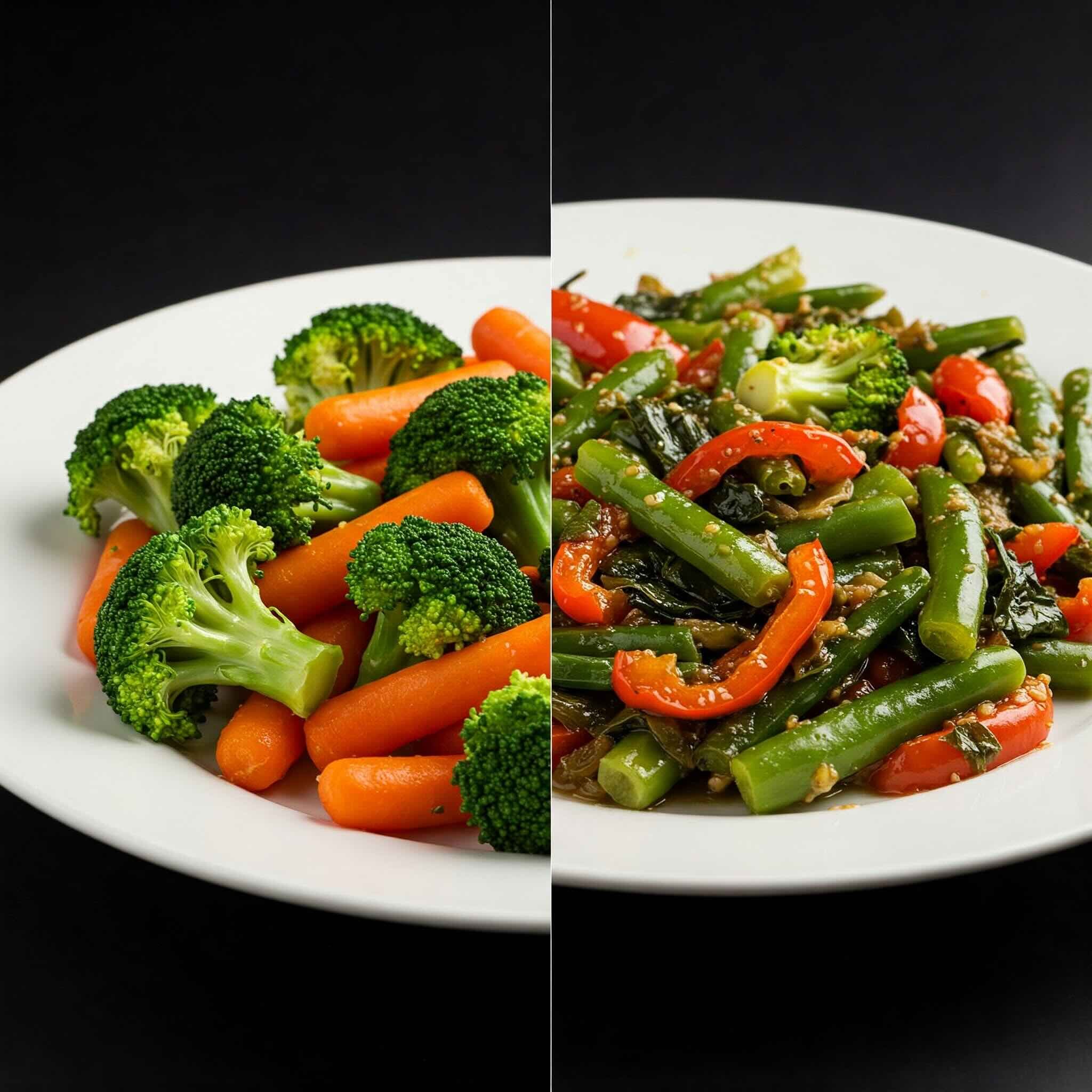Are You Overcooking Veggies? Get Perfect Texture Every Time
Ever pulled a plate of roasted veggies from the oven, only to find them soft and lifeless? Or boiled greens that turned into soggy, dull mush? Overcooking vegetables is an easy mistake, but it’s one that kills flavour, texture, and nutrients.
Luckily, achieving perfectly cooked, crisp, and vibrant vegetables isn’t hard—once you understand how to control heat, time, and moisture.
Let’s break down the common mistakes, best cooking methods, and expert tricks to help you avoid overcooked veggies forever! 🚀
🌱 Why Overcooking Vegetables Is a Big Problem
✔ Nutrient Loss – Vitamins like C and B are water-soluble, meaning they leach out into cooking water.
✔ Soggy Texture – Vegetables become mushy when overcooked, losing their natural structure.
✔ Dull Colour – Instead of bright greens and vibrant oranges, overcooked veggies turn brownish and unappetising.
✔ Flat Flavour – Cooking too long removes natural sweetness and depth, leaving a bland, overdone taste.
🔥 Pro Tip: Perfectly cooked veggies should be tender but firm, with bright colours and a fresh bite! 🥕
🔥 The Best Cooking Methods to Avoid Mushy Veggies
1️⃣ Blanching – Lock in Colour & Crispness
✔ Best For: Green beans, broccoli, asparagus, leafy greens.
✔ How to Do It:
Bring a pot of salted water to a rolling boil.
Drop in veggies for 30 seconds to 2 minutes (depending on size).
Immediately transfer to ice water to stop cooking.
🔥 Pro Tip: Blanching before stir-frying or roasting helps veggies stay crisp and bright! 🥦
2️⃣ Steaming – Gentle Cooking for Retaining Nutrients
✔ Best For: Carrots, Brussels sprouts, cauliflower, zucchini.
✔ How to Do It:
Use a steamer basket over simmering water.
Steam just until fork-tender (4-7 minutes, depending on the veggie).
Remove immediately and season while warm.
🔥 Pro Tip: For extra flavour, steam veggies with fresh garlic, lemon zest, or herbs in the water! 🍋
3️⃣ Roasting – For Crispy, Deep Flavours
✔ Best For: Root vegetables (potatoes, beets, carrots), bell peppers, Brussels sprouts.
✔ How to Do It:
Preheat oven to 200-220°C (400-425°F).
Toss veggies with oil, salt, and spices.
Spread in a single layer on a baking tray.
Roast for 15-45 minutes, flipping halfway through.
🔥 Pro Tip: Don’t crowd the baking tray—spread veggies out so they roast instead of steaming!🔥🥔
4️⃣ Stir-Frying – Quick & Crunchy
✔ Best For: Bell peppers, snow peas, mushrooms, bok choy.
✔ How to Do It:
Heat a wok or pan over high heat.
Add a high-smoke-point oil (avocado, peanut, or refined vegetable oil).
Stir-fry veggies for 2-5 minutes, tossing constantly.
🔥 Pro Tip: Cook veggies in batches to prevent overcrowding and steaming! 🍜🔥
5️⃣ Sautéing – Perfect for Soft but Not Mushy Veggies
✔ Best For: Onions, zucchini, mushrooms, leafy greens.
✔ How to Do It:
Heat a pan over medium heat with a small amount of oil.
Cook veggies until softened but still vibrant (4-8 minutes).
Add aromatics like garlic, ginger, or herbs for extra depth.
🔥 Pro Tip: Deglaze the pan with lemon juice or vinegar at the end to brighten flavours! 🍷
🥕 How Long to Cook Different Veggies (Without Overcooking!)
🥦 Broccoli & Green Beans: 3-5 min (blanch/stir-fry), 15-20 min (roast).
🥕 Carrots: 4-7 min (steam), 20-30 min (roast).
🍆 Eggplant & Zucchini: 5-7 min (sauté), 20-25 min (roast).
🌽 Corn on the Cob: 5-7 min (boil/steam), 20 min (grill).
🥔 Potatoes: 10-15 min (boil), 30-45 min (roast).
🔥 Pro Tip: Always test veggies early with a fork—remove them from heat before they become soft! 🥄
❌ Common Overcooking Mistakes (And How to Fix Them)
🚫 Boiling veggies too long? → Use blanching instead to keep them crisp.
🚫 Soggy stir-fry? → Cook over higher heat and in smaller batches.
🚫 Dull, lifeless greens? → Steam or blanch, then shock in ice water to keep them bright.
🚫 Roasted veggies too soft? → Increase oven temp to 200°C+ for a better crisp.
🔥 Pro Tip: If you overcook veggies, blend them into soups or sauces instead of tossing them! 🍵
🌟 Final Takeaway: Cook Smart, Keep Veggies Vibrant
Cooking vegetables just right keeps their flavours fresh, colours vibrant, and textures satisfying.
✔ Blanch or steam for crisp, bright veggies.
✔ Roast for deep, caramelised flavour.
✔ Stir-fry or sauté for quick, fresh meals.
✔ Test doneness early—don’t wait until they’re soft!
🔥 Your Turn: What’s your go-to method for cooking veggies? Share your best tips below! 🥦✨

